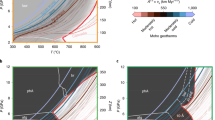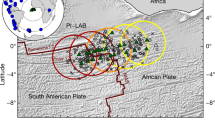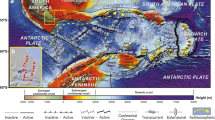Abstract
The global geoid is characterized by a semi-continuous belt of lows that surround the Pacific Ocean, including isolated minima in the Indian Ocean, Ross Sea and northeast Pacific and west Atlantic oceans. These geoid lows have been attributed to Mesozoic subduction1,2. Geodynamic models that include slab graveyards in the lower mantle as inferred from seismic topography or from plate reconstructions correctly predict the general trend of geoid minima3,4. However, these models fail to accurately reproduce localized geoid lows in the Indian Ocean, Ross Sea and northeast Pacific Ocean. Here we show that the geoid lows are correlated with high-velocity anomalies near the base of the mantle and low-velocity anomalies in the mid-to-upper mantle. Our mantle flow models reproduce the geoid minima if the mid-to-upper mantle upwellings are positioned above the inferred locations of ancient subducted slabs. We find that the long-wavelength trough in the geoid is linked to high-density slab graveyards in the lower mantle, whereas upwelling regions in the mantle above 1,000 km depth cause discrete lows within the larger trough. We suggest that this mode of upwelling in the mid-to-upper mantle is caused by buoyant hydrated mantle that was created by processes around and above subducted slabs.
This is a preview of subscription content, access via your institution
Access options
Subscribe to this journal
Receive 12 print issues and online access
$259.00 per year
only $21.58 per issue
Buy this article
- Purchase on Springer Link
- Instant access to full article PDF
Prices may be subject to local taxes which are calculated during checkout


Similar content being viewed by others
References
Chase, C. G. & Sprowl, D. R. The modern geoid and ancient plate boundaries. Earth Planet. Sci. Lett. 62, 314–320 (1983).
Richards, M. & Engebretson, D. Large-scale mantle convection and the history of subduction. Nature 355, 437–440 (1992).
Steinberger, B. Slabs in the lower mantle—results of dynamic modelling compared with tomographic images and the geoid. Phys. Earth Planet. Inter. 118, 241–257 (2000).
Hager, B. H. & Richards, M. A. Long-wavelength variations in Earth’s geoid—physical models and dynamic implications. Phil. Trans. R. Soc. A 328, 309–327 (1989).
Kaban, M. K., Schwintzer, P. & Reigber, C. A new isostatic model of the lithosphere and gravity field. J. Geodesy. 78, 368–385 (2004).
Simons, M. & Hager, B. Localization of the gravity field and the signature of glacial rebound. Nature 390, 500–504 (1997).
Richards, M. A., Hager, B. H. & Sleep, N. H. Dynamically supported geoid highs over hotspots—observation and theory. J. Geophys. Res. 93, 7690–7708 (1988).
Billen, M. I., Gurnis, M. & Simons, M. Multiscale dynamics of the Tonga–Kermadec subduction zone. Geophys. J. Int. 153, 359–388 (2003).
Richards, M. A. & Hager, B. H. Geoid anomalies in a dynamic Earth. J. Geophys. Res. 89, 5987–6002 (1984).
van der Lee, S., Regenauer-Lieb, K. & Yuen, D. A. The role of water in connecting past and future episodes of subduction. Earth Planet. Sci. Lett. 273, 15–27 (2008).
Sutherland, R., Spasojevic, S. & Gurnis, M. Mantle upwelling after Gondwana subduction death may explain anomalous topography of West Antarctica and subsidence history of eastern New Zealand. Geology 38, 155–158 (2009).
Forte, A. M. & Mitrovica, J. X. Deep-mantle high-viscosity flow and thermochemical structure inferred from seismic and geodynamic data. Nature 410, 1049–1056 (2001).
Steinberger, B. & Calderwood, A. R. Models of large-scale viscous flow in the Earth’s mantle with constraints from mineral physics and surface observations. Geophys. J. Int. 167, 1461–1481 (2006).
Yoshida, M. & Nakakuki, T. Effects on the long-wavelength geoid anomaly of lateral viscosity variations caused by stiff subducting slabs, weak plate margins and lower mantle rheology. Phys. Earth Planet. Inter. 172, 278–288 (2009).
Cadek, O. & Fleitout, L. Effect of lateral viscosity variations in the top 300 km on the geoid and dynamic topography. Geophys. J. Int. 152, 566–580 (2003).
Billen, M. I. & Gurnis, M. A low viscosity wedge in subduction zones. Earth Planet. Sci. Lett. 193, 227–236 (2001).
Ritsema, J., van Heijst, H. J. & Woodhouse, J. H. Global transition zone tomography. J. Geophys. Res. 109, B02302 (2004).
Masters, G., Laske, G., Bolton, H. & Dziewonski, A. in The Relative Behaviour of Shear Velocity, Bulk Sound Speed, and Compressional Velocity in the Mantle: Implications for Chemical and Thermal Structure (eds Karato, S. I. et al.) 63–88 (Geophysical Monograph Series, Vol. 117, American Geophysical Union, 2000).
Simmons, N. A., Forte, A. M. & Grand, S. P. Constraining mantle flow with seismic and geodynamic data: A joint approach. Earth Planet. Sci. Lett. 246, 109–124 (2006).
Grand, S. P. Mantle shear-wave tomography and the fate of subducted slabs. Phil. Trans. R. Soc. A 360, 2475–2491 (2002).
Spasojevic, S., Gurnis, M. & Sutherland, R. Inferring mantle properties with an evolving dynamic model of the Antarctica–New Zealand region from the Late Cretaceous. J. Geophys. Res. (in the press, 2010).
Aitchison, J. C., Ali, J. R. & Davis, A. M. When and where did India and Asia collide? J. Geophys. Res. 112, B05423 (2007).
Fleitout, L. & Singh, R. N. 17th Math. Geophys. Con. 143 (1988).
Gurnis, M., Müller, R. & Moresi, L. Cretaceous vertical motion of Australia and the Australian–Antarctic discordance. Science 279, 1499–1504 (1998).
Spasojevic, S., Liu, L. J. & Gurnis, M. Adjoint models of mantle convection with seismic, plate motion, and stratigraphic constraints: North America since the Late Cretaceous. Geochem. Geophys. Geosyst. 10, Q05W02 (2009).
Courtillot, V., Davaille, A., Besse, J. & Stock, J. Three distinct types of hotspots in the Earth’s mantle. Earth Planet. Sci. Lett. 205, 295–308 (2003).
Ohtani, E., Litasov, K., Hosoya, T., Kubo, T. & Kondo, T. Water transport into the deep mantle and formation of a hydrous transition zone. Earth Planet. Sci. Lett. 143–144, 255–269 (2004).
Hirschmann, M. M. Water, melting, and the deep Earth H2O cycle. Annu. Rev. Earth Planet. Sci. 34, 629–653 (2006).
Tan, E., Choi, E., Thoutireddy, P., Gurnis, M. & Aivazis, M. GeoFramework: Coupling multiple models of mantle convection within a computational framework. Geochem. Geophys. Geosyst. 7, Q06001 (2006).
Gudmundsson, O. & Sambridge, M. A regionalized upper mantle (RUM) seismic model. J. Geophys. Res. 103, 7121–7136 (1998).
Acknowledgements
We thank R. Moucha for helpful comments on an earlier version of the letter. This work was supported through Caltech Tectonics Observatory (by the Gordon and Betty Moore Foundation), the National Science Foundation (EAR-0609707 and EAR-0810303), the New Zealand Foundation for Research Science and Technology, and StatoilHydro. The original CitcomS software was obtained from CIG, Computational Infrastructure for Geodynamics (http://geodynamics.org). This is Contribution Number 10034 of the Division of Geological and Planetary Sciences and Number 217 of the Tectonics Observatory, Caltech.
Author information
Authors and Affiliations
Contributions
S.S. carried out analysis and mantle convection modelling, and all authors participated in the modelling strategy, interpretation of results and preparing the manuscript.
Corresponding author
Ethics declarations
Competing interests
The authors declare no competing financial interests.
Supplementary information
Supplementary Information
Supplementary Information (PDF 7107 kb)
Rights and permissions
About this article
Cite this article
Spasojevic, S., Gurnis, M. & Sutherland, R. Mantle upwellings above slab graveyards linked to the global geoid lows. Nature Geosci 3, 435–438 (2010). https://doi.org/10.1038/ngeo855
Received:
Accepted:
Published:
Issue Date:
DOI: https://doi.org/10.1038/ngeo855
This article is cited by
-
Effect of Mantle Viscosity Structures on Simulations of Geoid Anomalies in the Ross Sea Area
Pure and Applied Geophysics (2022)
-
Gravity Maps of the Lithospheric Structure Beneath the Indian Ocean
Surveys in Geophysics (2019)
-
Modeling Long-Wavelength Geoid Anomalies from Instantaneous Mantle Flow: Results from Two Recent Tomography Models
Pure and Applied Geophysics (2019)
-
The South India Precambrian crust and shallow lithospheric mantle: Initial results from the India Deep Earth Imaging Experiment (INDEX)
Journal of Earth System Science (2013)



